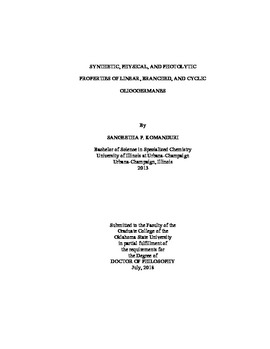| dc.contributor.advisor | Weinert, Charles S. | |
| dc.contributor.author | Komanduri, Sangeetha | |
| dc.date.accessioned | 2019-03-22T18:57:16Z | |
| dc.date.available | 2019-03-22T18:57:16Z | |
| dc.date.issued | 2018-07 | |
| dc.identifier.uri | https://hdl.handle.net/11244/317677 | |
| dc.description.abstract | The following dissertation focuses on the synthesis and characterization of unique linear, branched, cyclic germanium compounds to further the knowledge and scope of organometallic chemistry of the element. In chapter II a 2-germanium atom end capping reagent was used for synthesis of longer linear oligomer using monohydride Ph3GeGePh2H. This species was observed to be thermally unstable upon heating the material to 200 °C. Thermal decomposition products were identified as Ph3GeH and assumed germylene (Ph2Ge:), which subsequently polymerized. Reactions were monitored by NMR (1H and 13C) spectroscopy and characterized using X-ray crystallography. | |
| dc.description.abstract | A series of linear oligomers R3Ge(GePh2)nGeR3 (n = 0 or 1), were synthesized and subsequently photolyzed. The photodecomposition pathways of these compounds were analyzed after exposure to UV-C light (280-100 nm) in the presence of acetic acid, acting as a germylene trapping agent. Resulting photoproducts showed germylene (Ph2Ge:) extrusion and germyl radical formation (R3Ge) to yield R2Ge(H)OAc and R3GeOAc, R3GeH and R3GeGeR3 respectively. Photoproducts were identified by 1H NMR, electron impact gas-chromatography (EI-GC/MS), and high resolution accurate mass-mass spectrometry (HRAM-MS). Three branched oligogermanes (Me3Ge)3GePh, (Me2ButGe)3GePh, (Me2PhGe)3GePh, and (Bu3nGe)3GePh were synthesized and characterized. All species were prepared and characterized by NMR (1H, 13C, and 73Ge) and HRAM-MS. The varying substituent composition on the peripheral R3Ge- groups provided insight on the electronic properties studied by cyclic/differential pulse voltammetry (CV and DPV) and UV-visible spectroscopy. | |
| dc.description.abstract | Chapter V describes the synthesis of a series Pri3Ge(GePh2)nGePri3 (n = 0-3) linear oligomers. Compounds were characterized using NMR (1H and 13C), UV-vis, and CV/DPV. A bathochromic shift was seen via Ge - Ge chain elongation, and species became easier to oxidize. Crystals of the pentagermane showed dichroism and luminescence, the smallest discrete oligomer to exhibit polymeric like properties. The final chapter focuses on the synthesis of perarylated cyclotetra- (Ar2Ge)4 and cyclopentagermanes (Ar2Ge)5 (Ar = 2,5-xylyl), using Ar2GeCl2 as the precursor. These species were selected to increase solubility in ring opening reactions with an alkali metal. Crystals were only obtained in experimental conditions for (Ar2Ge)4. However, the expected product turned out to be a germyl-substituted cyclogermane ClGeAr2(Ge4Ar7), the first compound of its class to be synthesized. | |
| dc.format | application/pdf | |
| dc.language | en_US | |
| dc.rights | Copyright is held by the author who has granted the Oklahoma State University Library the non-exclusive right to share this material in its institutional repository. Contact Digital Library Services at lib-dls@okstate.edu or 405-744-9161 for the permission policy on the use, reproduction or distribution of this material. | |
| dc.title | Synthetic, physical, and photolytic properties of linear and cyclic oligogermanes | |
| dc.contributor.committeeMember | Apblett, Allen | |
| dc.contributor.committeeMember | Bunce, Richard A. | |
| dc.contributor.committeeMember | Nelson, Toby L. | |
| dc.contributor.committeeMember | Veenstra, John N. | |
| osu.filename | Komanduri_okstate_0664D_15909.pdf | |
| osu.accesstype | Open Access | |
| dc.type.genre | Dissertation | |
| dc.type.material | Text | |
| thesis.degree.discipline | Chemistry | |
| thesis.degree.grantor | Oklahoma State University | |
